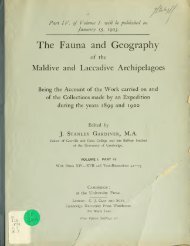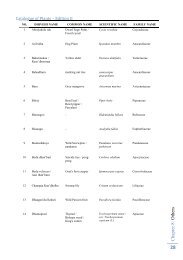Download - WordPress – www.wordpress.com
Download - WordPress – www.wordpress.com
Download - WordPress – www.wordpress.com
You also want an ePaper? Increase the reach of your titles
YUMPU automatically turns print PDFs into web optimized ePapers that Google loves.
:690 L. A. BORRADAILE.26. Lambrus (Rhinolambrus) gracilis Dana, 1852. Alcock, I. p. 269.The specimens which I assign to this species agree with Alcock's description fully,except that the surface of the carapace is not absolutely smooth, there being several granulesround the cardiac spine and along the branchial ridges.Dredged in Felidu, Fadifolu and Suvadiva Atolls, in 22—43 fathoms.27. Lambrus (Rhinolambrus) turriger Ad. and Wh., 1847. Alcock, i. p. 269 (PI. XLVII.fig. 5).Dredged in South Nilandu, Felidu, Mulaku, Haddumati, Suvadiva, Kolumadulu andNorth Male Atolls, in 2.5—42 fathoms.28. Lambrus (Aulacolambrus) sculptus A. M.-Edw., 1872. Alcock, i. p. 272 (PI. XLVII.fig. 6).Dredged in South Nilandu, Felidu, Mulaku, and Suvadiva Atolls, in 20—43 fathoms.29. Lambrus (Parthenolavibrus) calappoides Ad. and Wh., 1847. Alcock, i. p. 275.Dredged in South Nilandu and Suvadiva in 36 and 35 fathoms respectively.XI.ON THE CLASSIFICATION AND GENEALOGY OF THEREPTANT DECAPODS.Besides the brachyurous Crabs, Boas' Reptantia' <strong>com</strong>prised sundry groups which are notbrachyurous, that is have a pair of biramous limbs on the sixth segment of the abdomen,which bears traces of adaptation to other purposes than reproduction, such as swimmingor holding on a shell, and have also no fusion between the rostrum or front and theepistome and no angle on the endopodite of the first maxilliped. The following are thenames of these groups : Eryonidea, Scyllaridea (= Loricata), Nephropsidea (= Homaridea andAstacidea), Thalassinidea, Paguridea, Galatheidea, and Hippidea, the last three being togetherknown as Anomala by Boas and most other writers.Our present object is to arrange these divisions according to their relationships, and todo this we must first of all form an idea of the ancestor from which they may be supposedto be descended. More space would be needed than can be spared here to set forth indetail the process of <strong>com</strong>parison of the various types with one another and with the prawnsof the Stenopidea and Penaeidea, by which this result may be reached, and indeed thismight after all be hardly worth while, for the following statement will, I think, <strong>com</strong>menditself to those who have studied the subject as on the whole probable.The forebears of the reptant Decapods, if they could be examined, would probably showthe following characters(1) The rostrum of a good size, flat but keeled, and narrowly triangular.(2) The carapace subcylindrical, free from the epistome both at the sides and in the middle,overlapped behind by a process of the first abdominal segment on each side, and marked by thefollowing grooves : on the back two running transversely (the first, line e of Boas, is Bouvier's' See above, Art. iv. vol. i. p. 424.






